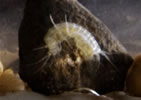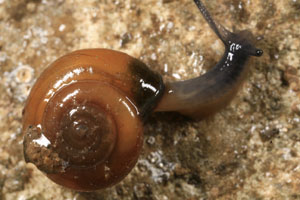SLUGS AND SNAILS
Slugs and snails are examples of Molluscs. Most of the living molluscs in caves are gastropods and many are omnivores – like man they feed on a variety of food types.
Snails
Most snails are found amongst detritus in the threshold zone. The Glass Snails include Oxychilus sp. and are common in caves.
Oxychilus cellarius, O. draparnaldi, Discus rotundatus and Vitrea crystallina can be found quite deep in the threshold, even within the dark zone, tucked away in damp crevices. All are widely distributed.
Oxychililus species have carnivorous tendencies e.g. the Cellar snail Oxychilus cellarius produces chitinase enzymes to digest the chitin in the exoskeletons of insects. O. helveticus has been recorded in a few caves. Many representatives of this group give off distinctive odours such as garlic.
|
Oxchilus sp., Albert's Cave |
The Helicigona lapicida snail is found in limestones areas as far north as Yorkshire and has been recorded in Ibbeth Peril.
|
Arianta arbustorum, Ibbeth Peril |
The Common Garden snail Cornu aspersum is frequent in the caves around Morecambe Bay e.g. Hale Moss Cave.
The Bivalves (so named because they have two shells (valves) joined together by a hinge) are another group of molluscs found in both fresh and marine waters. Marine bivalves include creatures like the cockles and razor shells etc. Freshwater bivalves rarely occur in caves, although numerous specimens of the tiny Red-crusted Pea mussel, Pisidium personatum have been found in Hazel Grove Main Cave, Morecambe.
Slugs are occasionally found in the threshold of caves. Some species are difficult to identify without examination of the internal anatomy.
|



.jpg)